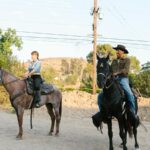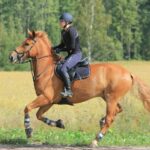Riding a horse that refuses to slow down or stop can be not just frustrating but genuinely dangerous. This common equestrian problem, often referred to as “heavy on the forehand” or “running through the bit,” can transform an enjoyable ride into a nerve-wracking experience. Whether you’re dealing with a young horse still learning the basics, an excited trail horse, or a seasoned mount with developed bad habits, regaining control requires patience, consistent training, and appropriate techniques. In this comprehensive guide, we’ll explore the causes behind a horse’s reluctance to stop and provide practical solutions to address this challenging behavior.
Understanding Why Horses Won’t Stop

Before attempting to fix any behavioral issue, it’s essential to understand the potential causes behind your horse’s reluctance to slow down or stop. Horses may ignore stopping cues for various reasons, including inadequate training, physical discomfort, fear, or excitement. Some horses develop a habit of “running through the bit” when they’ve learned they can overpower their riders, creating a dangerous dynamic. Others may be responding to rider tension, inadvertently receiving mixed signals, or experiencing pain from ill-fitting tack. Identifying the root cause of your specific situation will help determine the most effective approach to resolving the issue and rebuilding reliable communication with your equine partner.
Rule Out Physical Issues First

When a horse suddenly develops stopping problems or consistently ignores your cues, the first step should be ruling out any physical issues that might be causing pain or discomfort. Have an equine dentist check for sharp edges on teeth, wolf teeth, or other dental issues that might make bit contact uncomfortable. Consult with your veterinarian to evaluate potential back pain, arthritis, or other musculoskeletal problems that could be causing your horse to rush forward rather than collect and stop. Have a professional saddle fitter assess your tack to ensure it distributes weight properly and doesn’t pinch or create pressure points. Remember that horses rarely “misbehave” without reason, and physical discomfort is often the underlying cause of resistance to basic cues.
Check Your Equipment Setup

The right equipment can make a significant difference when addressing stopping issues, though it’s important to view tack as a communication tool rather than a mechanical solution. Evaluate whether your bit is appropriate for your horse’s training level and mouth conformation—sometimes a horse that’s heavy in the bridle needs a different bit design rather than a harsher bit. Consider if a properly fitted running martingale might help prevent your horse from raising its head too high and evading bit pressure. For some horses, switching to a bitless option like a hackamore or sidepull might eliminate mouth pain that’s causing the running behavior. Remember that equipment should enhance communication, not substitute for proper training, and any tool is only as effective as the hands using it.
Improve Your Riding Position

Your body position significantly impacts your horse’s balance and responsiveness to stopping cues. Many riders inadvertently encourage forward motion by leaning forward, gripping with their legs, or becoming stiff through their hips and lower back. Focus on maintaining a balanced, upright posture with your shoulders aligned over your hips and heels. When asking for a stop, avoid the common mistake of leaning back and pulling on the reins, which can throw your horse off balance and create resistance. Instead, deepen your seat by engaging your core muscles, stop your posting or movement, and think about “sitting heavy” while maintaining elastic contact with the reins. This balanced position communicates your intent to stop while allowing your horse to shift its weight to the hindquarters properly.
Establish Clear Verbal Cues

Verbal cues can be powerful tools when consistently paired with physical aids for stopping and slowing down. Begin incorporating a clear verbal command like “whoa” or “easy” before applying your physical stopping aids. Use your stopping word in a low, steady tone that signals relaxation rather than excitement. Practice these verbal cues during groundwork sessions, rewarding your horse immediately when it responds correctly, which helps build the association between the word and the desired action. For maximum effectiveness, be consistent with your terminology—don’t interchange words like “whoa,” “ho,” and “easy” if you expect them to signal different actions. Over time, many horses will begin responding to verbal cues alone, which can be invaluable in situations where your physical aids might be compromised.
Master the Half-Halt Technique

The half-halt is a fundamental riding skill that helps rebalance your horse and regain attention without fully stopping. This subtle communication involves momentarily increasing connection with your horse’s mouth while simultaneously deepening your seat and core engagement, essentially asking your horse to shift weight to the hindquarters and prepare for a transition. Begin practicing half-halts during calm moments rather than when your horse is already rushing, applying a gentle squeeze-and-release motion with your reins while slightly increasing pressure with your seat. The timing should feel like catching a ball—a momentary connection followed by release when your horse responds by slowing or rebalancing. Regular, correctly executed half-halts can dramatically improve your horse’s responsiveness and help prevent the running-through-the-bit behavior before it escalates.
Use Suppling Exercises and Transitions

A horse that’s physically flexible and mentally engaged is much more likely to respond properly to stopping cues. Incorporate plenty of suppling exercises into your regular training routine, including lateral movements like leg-yields, shoulder-in, and haunches-in, which improve your horse’s responsiveness to individual aids. Frequent transitions between gaits—walk to trot, trot to canter, and back down—help your horse stay mentally focused and physically prepared to respond to your cues. Start with large, gentle circles and gradually decrease their size as your horse becomes more balanced and responsive. Serpentines and figure-eights can be particularly effective for horses that tend to build momentum and ignore stopping aids, as these patterns naturally encourage the horse to rebalance and pay attention to the rider.
Practice the One-Rein Stop

The one-rein stop serves as both a training tool and an emergency technique for horses that won’t respond to normal stopping aids. This method involves bringing one rein toward your hip in a smooth motion while releasing the other rein, causing your horse to flex at the poll and bend through the neck, making it physically difficult to continue rushing forward. Practice this technique at the walk and trot in a safe, enclosed area before you need it in an emergency situation. Always use the one-rein stop in a controlled manner; pulling too abruptly can unbalance your horse and cause a fall. When teaching this technique, immediately release pressure and praise your horse when it slows or stops, then gradually build duration. The goal is to eventually transition from the one-rein stop to conventional stopping aids as your horse becomes more responsive.
Implement Pattern Work and Circles

Horses that rush or ignore stopping cues often benefit from structured pattern work that naturally encourages them to regulate their pace. Begin with large circles at the walk and trot, focusing on maintaining even, rhythmic strides rather than allowing your horse to accelerate. Gradually spiral your circles smaller, which naturally requires your horse to slow down and balance, then spiral back out, repeating this exercise until your horse remains responsive to subtle speed adjustments. Incorporate patterns like figure-eights, serpentines, and direction changes that require your horse to think and adjust rather than simply rush forward. These exercises have the added benefit of developing the hindquarter engagement necessary for proper stops while mentally engaging your horse and breaking the habit of mindlessly rushing forward.
Retrain Basic Stop Cues from the Ground

Sometimes the most effective approach is to return to basics with groundwork, especially for horses that have developed negative associations with stopping under saddle. Begin with in-hand work, leading your horse at the walk and incorporating clear, consistent stopping cues: a verbal “whoa,” ceasing your forward movement, and a gentle backward pressure on the lead rope. Reward immediate responses with praise and release of pressure. Progress to longeing, where you can work on voice commands for transitions and stopping without the complication of a rider. Once your horse consistently responds to stopping cues on the ground, transfer this training to mounted work, maintaining the same clear, consistent cues. This ground-up approach often resolves confusion and rebuilds respect for stopping aids more effectively than continuing the struggle under saddle.
Build Endurance and Address Fitness Issues

Some horses rush or become difficult to stop because they lack the physical conditioning to maintain balanced, controlled work. A horse that’s primarily worked in an arena may become overly excited and difficult to control when taken on trails or open spaces simply because it has excess energy or inadequate fitness for the work being asked. Implement a progressive conditioning program that develops your horse’s cardiovascular fitness, muscular strength, and stamina appropriate for your discipline. Include hill work to strengthen hindquarters, which directly improves stopping ability by developing the muscles needed for collection. Remember that a properly conditioned horse will have the physical capacity to respond to stopping aids without resorting to rushing or leaning on the forehand due to fatigue.
Address Emotional and Environmental Factors

Horses are prey animals whose natural instinct when frightened is to flee—sometimes manifesting as rushing or ignoring stopping cues. If your horse consistently becomes difficult to stop in certain locations or situations, systematic desensitization may be necessary to address underlying anxiety. Begin by identifying specific triggers and gradually introducing your horse to these stimuli in controlled environments. For horses that become excited in groups, practice calm riding in progressively larger gatherings, rewarding relaxed behavior. Horses that rush toward the barn or gate (a common issue called “barn sour” behavior) benefit from consistent work near these areas, including stopping, backing, and circling, removing the reward of rushing home. With patience and consistency, most horses can learn to override instinctual responses and remain responsive regardless of environmental factors.
Seek Professional Help When Needed

Despite your best efforts, some stopping issues require professional intervention for safety and effectiveness. Consider working with a qualified trainer who specializes in remedial training if your horse’s stopping problems persist or worsen despite consistent work. An experienced professional can objectively assess the horse-rider combination, identifying subtle issues in your technique or approach that might be contributing to the problem. For particularly challenging cases, sending your horse for professional training for a period of time may reset negative patterns and establish reliable responses to stopping cues. Remember that seeking help isn’t admitting defeat—it’s prioritizing safety and setting both you and your horse up for long-term success.
Maintain Consistency and Patience

Perhaps the most crucial element in resolving stopping issues is maintaining absolute consistency in your expectations and aids. Horses learn through repetition and clear cause-and-effect relationships, so allowing your horse to ignore stopping cues even occasionally reinforces the very behavior you’re trying to eliminate. Set realistic goals for progress, celebrating small improvements rather than expecting immediate perfection. Remember that it typically takes much longer to retrain an established habit than to teach a behavior correctly from the beginning. Most stopping issues develop over months or years and won’t resolve overnight. With patient, systematic training focused on clear communication rather than confrontation, even the most resistant horses can learn to stop reliably, creating a safer and more enjoyable partnership.
Conclusion

Addressing a horse that won’t stop or slow down requires a multifaceted approach that considers physical, training, and psychological factors. By systematically ruling out pain, refining your technique, implementing appropriate exercises, and maintaining consistent expectations, you can transform a challenging and potentially dangerous situation into an opportunity to deepen your horsemanship skills and connection with your equine partner. Remember that true solutions address the underlying causes rather than merely suppressing symptoms, and the process of resolving stopping issues often results in improved communication across all aspects of your riding. With patience, consistency, and the right approach, you’ll develop a horse that stops willingly and promptly, creating a foundation of safety and trust for all your future equestrian endeavors.







